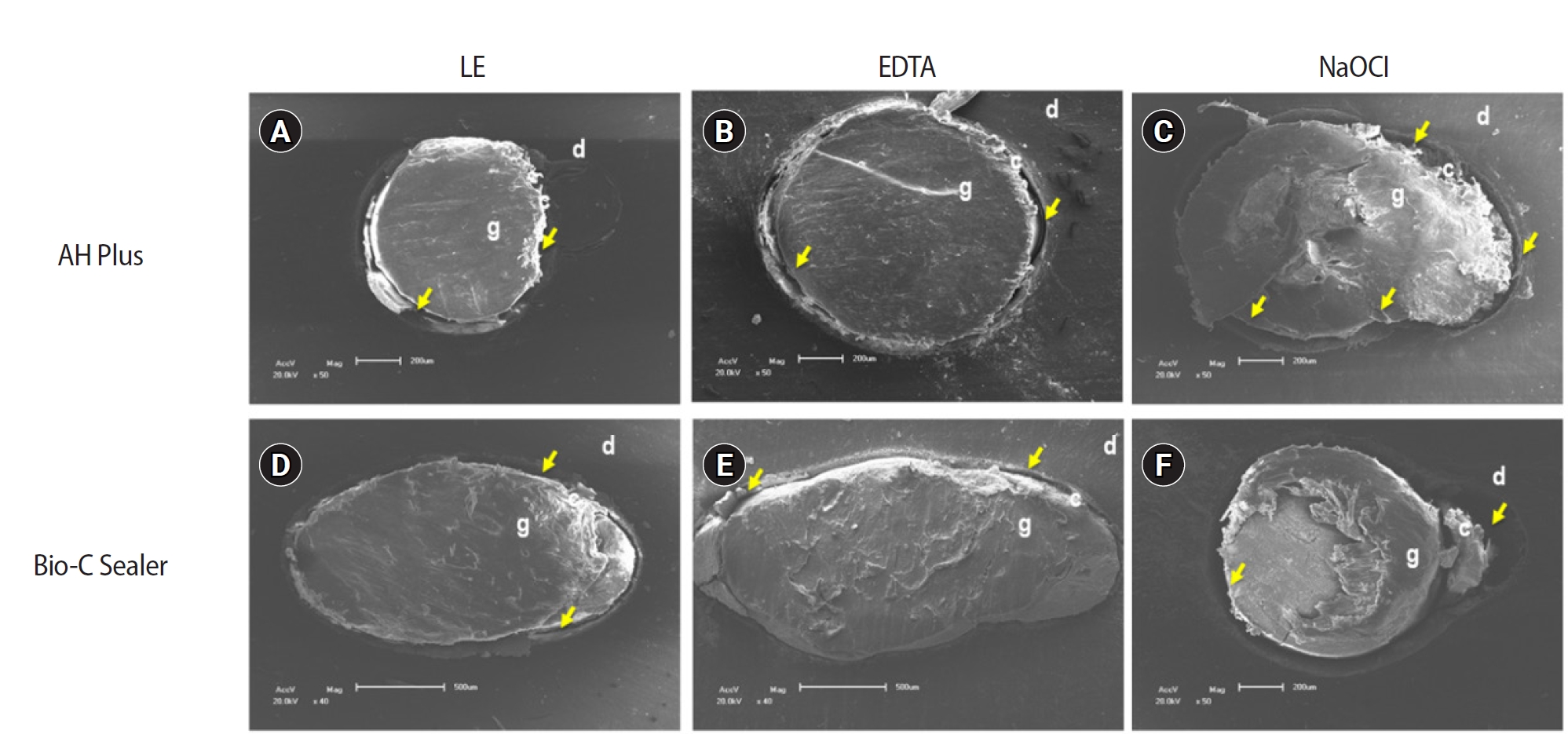-
The effect of limonene extract on the adhesion of different endodontic cements to root dentin: an in vitro experimental study
-
Nayara Lima Ferraz Aguiar, Eduardo José Soares, Guilherme Nilson Alves dos Santos, Anna Luísa Araújo Pimenta, Laryssa Karla Romano, Ricardo Gariba Silva, Fernanda de Carvalho Panzeri
-
Restor Dent Endod 2025;50(2):e16. Published online May 12, 2025
-
DOI: https://doi.org/10.5395/rde.2025.50.e16
-
-
 Abstract Abstract
 PDF PDF PubReader PubReader ePub ePub
- Objectives
The study aimed to evaluate the effect of limonene extract (LE) on push-out bond strength (BS) to root dentin in endodontically treated teeth.
Methods
Single-rooted teeth were selected and instrumented using the reciprocating technique, then divided into three groups based on the final irrigating solution: 2.5% sodium hypochlorite (NaOCl), 17% ethylenediaminetetraacetic acid (EDTA), and 5% LE. The roots were further divided (n = 12) and obturated using the single-cone technique with epoxy resin-based (ERB) or bioceramic sealer (Bio-C). After 3 days, the roots were sectioned into 2-mm slices, obtaining two slices from each root third. Push-out BS testing was conducted at 0.5 mm/min, followed by failure pattern and adhesive interface analysis using scanning electron microscopy. Push-out BS data were analyzed by three-way analysis of variance and Tukey post-hoc test (p < 0.05).
Results
ERB showed higher BS when irrigated with EDTA (5.0 ± 2.3 MPa) compared to NaOCl (1.8 ± 1.1 MPa) (p = 0.0005), particularly in the cervical third. LE yielded intermediate values without significant differences from the other irrigants (3.5 ± 1.9 MPa) (p > 0.05). For Bio-C, the highest BS was observed in the apical third, especially with LE (9.4 ± 5.0 MPa), differing from other thirds and final irrigating solutions (p < 0.05). Mixed failure patterns were most prevalent, regardless of the irrigant solutions.
Conclusions
The combination of LE with Bio-C demonstrated superior BS in the apical third, suggesting its potential as a final irrigating solution in endodontic treatments.
-
Analysis of the shelf life of chitosan stored in different types of packaging, using colorimetry and dentin microhardness
-
Antonio Miranda da Cruz-Filho, Angelo Rafael de Vito Bordin, Luis Eduardo Souza-Flamini, Débora Fernandes da Costa Guedes, Paulo César Saquy, Ricardo Gariba Silva, Jesus Djalma Pécora
-
Restor Dent Endod 2017;42(2):87-94. Published online March 27, 2017
-
DOI: https://doi.org/10.5395/rde.2017.42.2.87
-
-
 Abstract Abstract
 PDF PDF PubReader PubReader ePub ePub
- Objectives
Chitosan has been widely investigated and used. However, the literature does not refer to the shelf life of this solution. This study evaluated, through the colorimetric titration technique and an analysis of dentin micro-hardness, the shelf life of 0.2% chitosan solution. Materials and MethodsThirty human canines were sectioned, and specimens were obtained from the second and third slices, from cemento-enamel junction to the apex. A 0.2% chitosan solution was prepared and distributed in 3 identical glass bottles (v1, v2, and v3) and 3 plastic bottles (p1, p2, and p3). At 0, 7, 15, 30, 45, 60, 90, 120, 150, and 180 days, the specimens were immersed in each solution for 5 minutes (n = 3 each). The chelating effect of the solution was assessed by micro-hardness and colorimetric analysis of the dentin specimens. 17% EDTA and distilled water were used as controls. Data were analyzed statistically by two-way and Tukey-Kramer multiple comparison (α = 0.05). ResultsThere was no statistically significant difference among the solutions with respect to the study time (p = 0.113) and micro-hardness/time interaction (p = 0.329). Chitosan solutions and EDTA reduced the micro-hardness in a similar manner and differed significantly from the control group (p < 0.001). Chitosan solutions chelated calcium ions throughout the entire experiment. ConclusionsRegardless of the storage form, chitosan demonstrates a chelating property for a minimum period of 6 months.
-
Citations
Citations to this article as recorded by  - Chitosan’s Ability to Remove the Smear Layer—A Systematic Review of Ex Vivo Studies
Ana Ferreira-Reguera, Inês Ferreira, Irene Pina-Vaz, Benjamín Martín-Biedma, José Martín-Cruces
Medicina.2025; 61(1): 114. CrossRef - The Utilization of Chitosan and Arduino Interface in Making a Microplastic Filter
Kate Cyrene P. Pineda, Maeven Uriel A. Dela Cruz, Quirsten Daniel R. Repalda, Aldrin Jeynard A. Gonzales, DL Chaturika C. Douglas, Alina Siara D. Hajan, Julie Ann B. Real
International Journal of Innovative Science and Research Technology.2025; : 2742. CrossRef - Antimicrobial evaluation of root canal irrigants of natural sources with and without gamma radiation activation - An in vitro study
Hoda Raafat Yousri, Abeer Hashem Mahran, Ahmed Abdel Rahman Hashem, Amal A. El-Batouti
Endodontology.2024; 36(4): 383. CrossRef - Influence of Chitosan 0.2% in Various Final Cleaning Methods on the Bond Strength of Fiberglass Post to Intrarradicular Dentin
Naira Geovana Camilo, Alex da Rocha Gonçalves, Larissa Pinzan Flauzino, Cristiane Martins Rodrigues Bernardes, Andreza Maria Fábio Aranha, Priscilla Cardoso Lazari-Carvalho, Marco Aurélio de Carvalho, Helder Fernandes de Oliveira
Polymers.2023; 15(22): 4409. CrossRef - Evaluation and comparison of anti-inflammatory properties of ibuprofen using two drug delivery systems after third molar surgery: using chitosan microspheres as a carrier for local drug delivery in to the third molar socket and through the oral route
Karthik KP, Balamurugan R
British Journal of Oral and Maxillofacial Surgery.2021; 59(2): 191. CrossRef - Optimization of chitosan nanoparticle synthesis and its potential application as germination elicitor of Oryza sativa L.
K. Divya, Smitha Vijayan, Sreekumar Janardanan Nair, M.S. Jisha
International Journal of Biological Macromolecules.2019; 124: 1053. CrossRef - Crosstalk between chitosan and cell signaling pathways
Behrouz Farhadihosseinabadi, Amir Zarebkohan, Mohamad Eftekhary, Mohammad Heiat, Mehrdad Moosazadeh Moghaddam, Mazaher Gholipourmalekabadi
Cellular and Molecular Life Sciences.2019; 76(14): 2697. CrossRef
-
370
View
-
2
Download
-
7
Crossref
|






